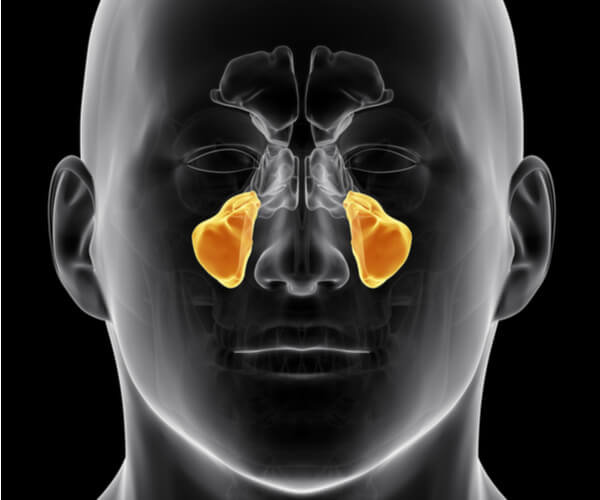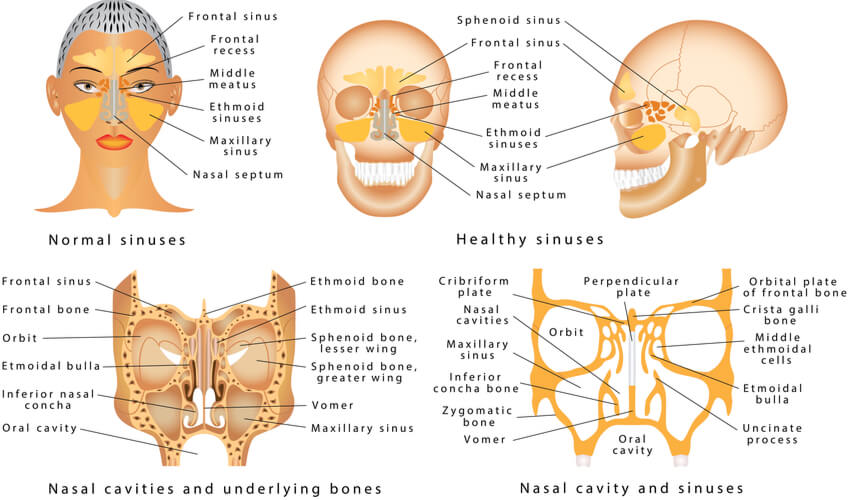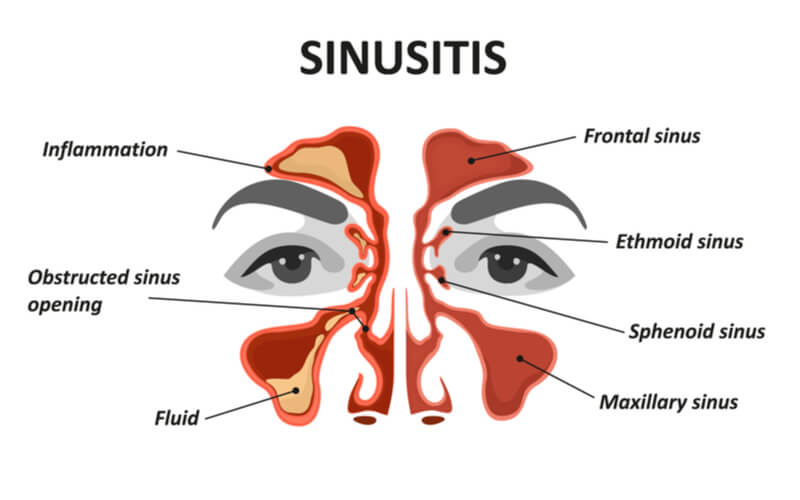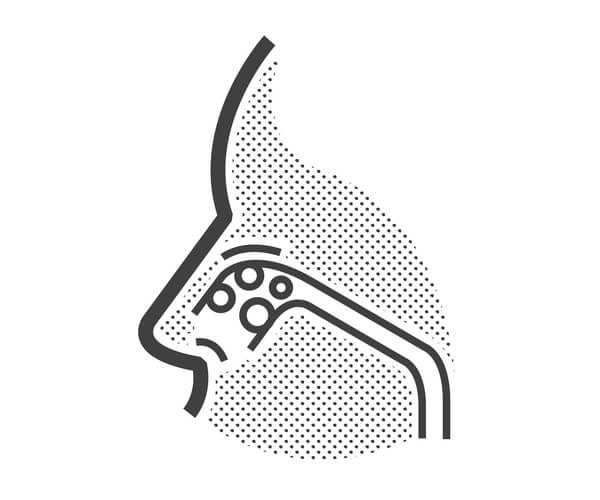Definition
The maxillary sinus is one of the four paranasal sinuses found near the nose that drains into the middle meatus via the osteomeatal complex.

Maxillary Sinus Location
There are actually two maxillary sinuses, both located in the maxilla, which is the fixed upper bone of the jaw formed by two maxillary bones fusing together. They are located laterally and slightly below the nasal cavities in the nose, and reside in the cheekbones.
Maxillary Sinus Anatomy
The maxillary sinus is the largest sinus in the body, and so the largest of the four paranasal sinuses. It contains three cavities:
- Alveolar recess – bounded by the alveolar process of the maxilla body, points downwards
- Zygomatic recess – bounded by the zygomatic bone, points laterally
- Infraorbital recess – bounded by the inferior orbital surface of the maxilla, points upwards
These recesses are surrounded by the walls of the maxillary sinus which, as mentioned previously, are formed by different parts of the surrounding bone:
- Anterior wall – formed by facial surface of maxilla
- Posterior wall – formed by infratemporal surface of maxilla
- Superior wall – formed by orbit floor
- Inferior wall – formed by alveolar and palatine processes of the maxilla
The maxillary sinus also contains a medial wall, which is rectangular and made primarily of cartilage. It separates the sinus from the nasal cavity. Some of the walls have grooves in them to house nerves and blood vessels.

The sinus is lined with a membrane called the Schneiderian membrane, which has ciliated pseudostratified columnar epithelial cells that produce mucus on the internal side, and periosteum on the osseous side (the side with bone).
In the maxillary sinus there is also an opening called the maxillary ostium (or the maxillary hiatus), which allows for drainage from the sinus into the posterior aspect of the hiatus semilunaris, and then into the middle meatus of the nasal cavity. The ostium is located on the medial wall near the roof of the maxillary sinus and is approximately 2.4mm in diameter. There are cilia near the maxillary ostium that beat towards it.
Maxillary Sinus Function
Though the exact functions of the maxillary sinus are not fully known, there have been several functions that scientists have hypothesized.
An example of one of these functions is that the maxillary sinus is believed to help warm and humidify any inhaled air before it enters the lungs. It is possible that the maxillary sinus may also contribute to the defense of the body against potentially pathogenic microbes by enriching protective factors such as lysozymes.

The maxillary sinus, and the other three paranasal sinuses, are also thought to help decrease the weight of the skull, which allows for enhanced voice resonation, reduced strain on the neck muscles, and enhanced balancing of the head and the neck, promoting its motility whilst upright.
Maxillary Sinus Disease
The maxillary sinuses can be afflicted by a number of different diseases and conditions, owing to several factors such as their close relationship with the often-infected respiratory tract. Examples of such diseases include:
Maxillary Sinusitis
Maxillary sinusitis is a condition where the maxillary sinuses become inflamed. Maxillary sinusitis can be caused by either a virus, bacteria or fungus, though acute sinusitis is most commonly caused by a bacterial infection, namely after a viral upper respiratory tract infection. The main culprits are usually Haemophilus, Streptococcus, Pneumococcus or Staphylococcus species. Maxillary sinusitis can also be caused by hay fever and other allergies.
The symptoms of acute maxillary sinusitis are:
- Maxillary sinus pain/pressure
- Nasal congestion/discharge
- Reduced smell perception
- Headache

Chronic maxillary sinusitis can often develop from an episode of acute sinusitis and may persist if there is poor drainage from the antrum to the nasal cavity. This reduction in drainage can be caused by a number of things, such as mechanical obstruction of the ostium or inhibited mucus clearance.
Typically acute maxillary sinusitis is usually treated just through relief of symptoms such as through the use of nasal decongestants and saline irrigation of the nose. Antibiotics are not often involved unless the patient begins to develop a fever or it seems like the infection has spread beyond the sinus.
Maxillary Sinus Cancer
Maxillary sinuses can (but rarely) develop tumors, both malignant and benign. There are several types of cancer that can occur in the sinus, such as:
- Adenocarcinoma – develops in the sinus lining
- Lymphomas – caused by immune or lymphatic cells
- Melanomas – develop from cells in the sinus lining that contain pigment
- Osteomas – noncancerous, but can still impede maxillary sinus
Papillomas (growths similar to warts caused by viral infections) can also grow in the sinuses, though around 90% are benign.

Most patients suffering from maxillary sinus cancer feel no symptoms early on, and so most cancers are diagnosed in the advanced stages. If the tumor is cancerous, then in stages 3 and 4 it will have spread to the bone around the maxillary sinus, the tissues under the skin, the lymph nodes, and in the last stage it will have spread to other parts of the body.
Maxillary sinus cancer is usually treated through surgical removal of the tumor followed by radiation therapy, though success depends on how early the cancer is caught.
